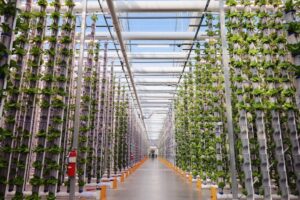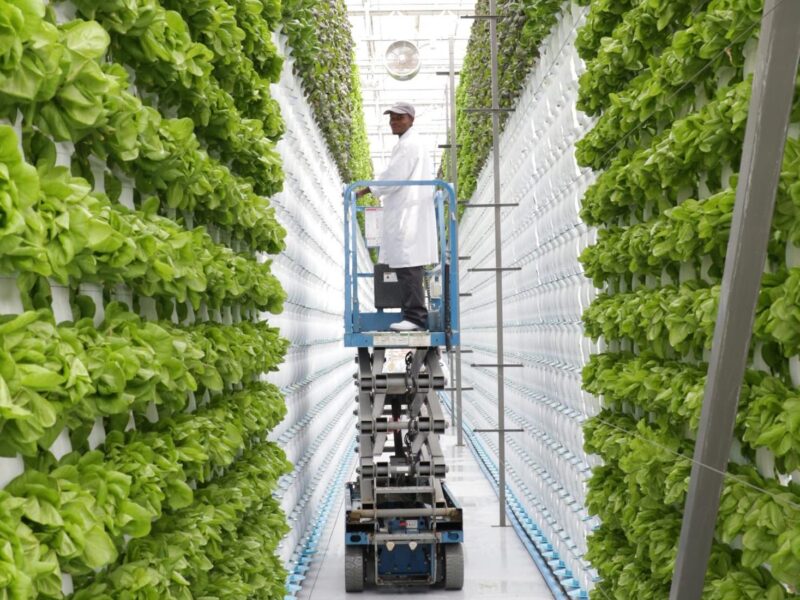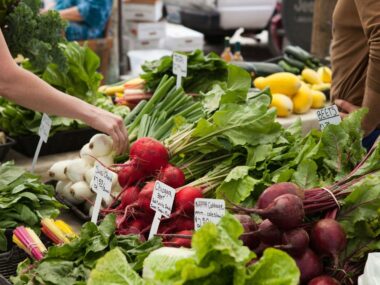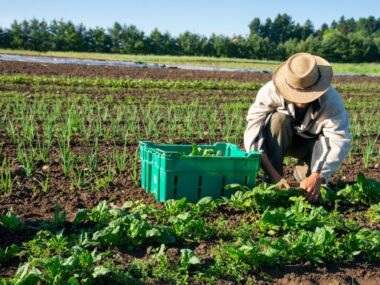Introduction:
As the global population continues to expand, coupled with urbanization and climate change challenges, the traditional methods of agriculture face unprecedented pressures to meet the rising demand for food. In this era of innovation, vertical farming emerges as a transformative solution, revolutionizing the way we grow crops and envision the future of food production. In this exploration, we delve into the concept of vertical farming, its potential benefits, technological advancements, and its role in shaping the future of agriculture.

Understanding Vertical Farming:
Vertical farming represents a paradigm shift in agriculture, where crops are cultivated in vertically stacked layers or structures, often in indoor environments such as warehouses, shipping containers, or high-rise buildings. Unlike conventional farming, which relies on vast expanses of arable land, vertical farming maximizes space utilization by growing crops upwards, utilizing advanced technologies such as hydroponics, aeroponics, and vertical farming systems.
Benefits of Vertical Farming:
Resource Efficiency: Vertical farming optimizes resource utilization by minimizing land footprint, water consumption, and energy inputs compared to traditional agriculture. By growing crops in controlled indoor environments, vertical farms can mitigate the effects of adverse weather conditions, reduce water wastage through precision irrigation systems, and minimize pesticide use, leading to more sustainable and environmentally friendly food production.
Year-Round Production: Vertical farming enables year-round crop production regardless of external climate conditions or seasonal variations. By providing ideal growing conditions, including consistent temperature, humidity, and lighting, vertical farms can produce fresh fruits, vegetables, and herbs continuously, meeting consumer demand for locally grown, seasonal produce even in urban areas or food-insecure regions.
Urban Agriculture: Vertical farming holds immense potential for urban agriculture, where space constraints and limited access to arable land pose challenges to conventional farming practices. By locating vertical farms in urban centers or vacant buildings, food can be grown closer to consumers, reducing transportation distances, carbon emissions, and food miles associated with conventional supply chains. Urban vertical farms also contribute to food security, community resilience, and economic development in urban areas.
Biodiversity and Ecosystem Preservation: Vertical farming minimizes the environmental impact of agriculture by reducing deforestation, habitat destruction, and soil degradation associated with conventional farming practices. By growing crops indoors using soilless cultivation methods, vertical farms conserve natural resources, protect biodiversity, and preserve fragile ecosystems, contributing to global conservation efforts and sustainable development goals.
Technological Advancements in Vertical Farming:
Controlled Environment Agriculture (CEA): Vertical farms employ advanced CEA technologies to create optimal growing conditions for crops, including temperature control, humidity regulation, and artificial lighting systems. Automated climate control systems, sensor networks, and data analytics enable precise monitoring and management of environmental parameters, ensuring optimal plant growth, yield, and quality.
Hydroponics and Aeroponics: Hydroponic and aeroponic systems are commonly used in vertical farming to cultivate crops without soil, using nutrient-rich water solutions or misting systems instead. These soilless cultivation methods offer several advantages, including increased water efficiency, faster growth rates, and higher yields compared to traditional soil-based farming, making them well-suited for vertical farming applications.
Vertical Farming Systems: Vertical farming systems range from modular vertical towers to fully automated vertical farms equipped with robotic systems for planting, harvesting, and maintenance. These scalable and customizable systems maximize space utilization, optimize resource efficiency, and enable high-density crop production in urban environments, catering to diverse market demands and consumer preferences.
LED Lighting Technology: LED lighting technology plays a crucial role in vertical farming by providing artificial light sources tailored to the specific light requirements of different crops. Energy-efficient LED grow lights mimic natural sunlight spectra, promoting photosynthesis and optimizing plant growth while minimizing energy consumption and operating costs, making them indispensable tools for indoor vertical farming operations.
The Future of Vertical Farming:
Vertical farming holds immense promise as a sustainable, efficient, and resilient approach to food production in the face of global challenges such as climate change, population growth, and urbanization. As technological advancements continue to drive innovation in vertical farming systems, we can expect to see further improvements in productivity, affordability, and scalability, making vertical farming an integral part of the future food system.
Conclusion:
In conclusion, vertical farming represents a transformative paradigm shift in agriculture, offering a sustainable, efficient, and innovative solution to the challenges of food security, environmental sustainability, and urbanization. By harnessing advanced technologies, optimizing resource utilization, and reimagining the way we grow and consume food, vertical farming has the potential to revolutionize the future of agriculture, ensuring a resilient, nutritious, and equitable food supply for generations to come. Let us embrace the promise of vertical farming and work towards a more sustainable and food-secure future for all.










